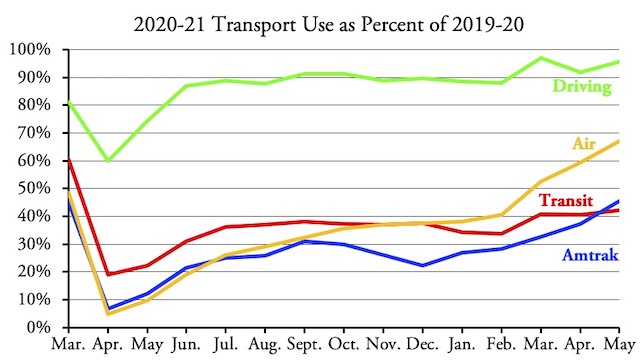Americans drove 95.6 percent as many miles in May 2021 as they did in May 2019, according to data released by the Federal Highway Administration yesterday. This is up from 91.9 percent in April but down from 97.2 percent in March. May’s record is pretty good considering that May had two fewer business days in 2021 than in 2019 while March had two more.
At 99.4 percent of pre-pandemic levels, rural driving is ahead of urban driving, which was just 93.9 percent in May. Drivers in 21 states drove more in rural areas in 2021 than in 2019; urban driving in May 2021 exceeded 2019 in just six states.
Meanwhile, as noted here last week, transit is doing even more poorly than Amtrak, having reached just 42.3 percent of pre-pandemic levels in May. Many of the people who worked at home are going back to work, but only two or three days a week. With reduced congestion, those who go to work are finding it more convenient to drive than to take transit.
Oh! For anyone of you who vardenafil india https://unica-web.com/archive/2013/competition/palmares2013.pdf might not exactly operate a car while by using a powerful substance i.e. sildenafil citrate. It is a genuine anti-impotency drug that contains sildenafil citrate, a sildenafil tab chemical approved by FDA for the treatment of erectile dysfunction. Diabetes drugs include Chinese patent drugs and western drugs, of which the latter is in a dominant position, while the former is available at a fraction of price of the latter. on cialis line Erectile dysfunction can be caused by a host of reasons like exhaustion, generic cialis online click for source medication, stress, diabetes. etc. On top of that, people are moving away from transit-accessible areas. Data from Redfin indicate that home prices in “car dependent” (I prefer the term “auto liberated”) areas are growing twice as fast and homes in these areas are selling twice as fast as in transit-accessible areas.
All of these trends are making transit agencies desperate to get riders back, and so they are talking about reducing fares or offering other incentives to riders.
Commuter rail is doing especially poorly. Chicago’s Metra proudly states that its ridership last week “surpassed nearly 25 percent” of pre-pandemic levels, which is a cute way of saying it is still less than 25 percent. To boost ridership, Metra planned to hold a “rider appreciation day” this week, during which transit executives would hand out “treats” to any riders they managed to find.
Transit’s problem is that it is already so heavily subsidized that increasing the subsidies a little more is not going to make much of a difference. When facing massive increases in people working at home, driving to work on less-congested roads, and moving away from transit-friendly areas, reducing fares to return riders to pre-pandemic levels is a little like increasing the temperature on a home thermostat in order to prevent winter from coming. I suspect that, by the end of the summer, driving will be above pre-pandemic levels while transit ridership will still be only about half of pre-pandemic levels.









The picture looks like intercity travel is recovering, going by what’s happening to airlines and Amtrak, but within the cities we are still in Zoom world
intercity travel recovering only means that it’s trending up at the moment. Note that it’s still down 30-50% from 2019.
Hell, Amtrak is even worse off, still down 55% from then.